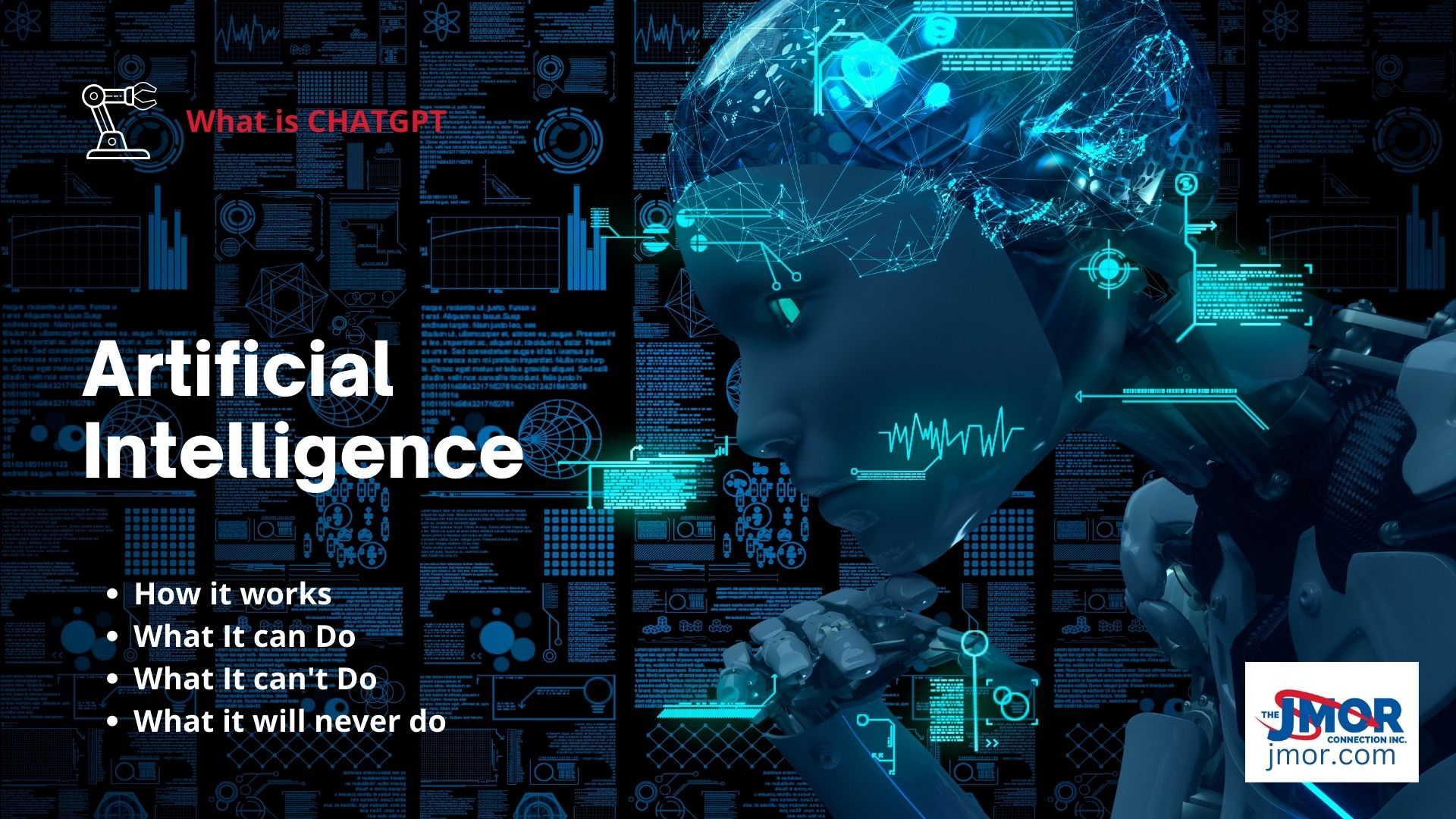ChatGPT seems to be popping up everywhere, but what is it, and what are its capabilities? ChatGPT was a guest on The JMOR Tech Talk Show recently, and I had an in-depth interview with this AI chatbot. Whenever new technology emerges, it does two things: get people excited to use it and create resistance to staying away from it. Through this article, I will share what ChatGPT is and many things it can’t do. At the end of the article, I will also include a link to The JMOR Tech Talk Show episode ChatGPT recently appeared on.
Chat-GPT is a chatbot where the GPT stands for generative pre-trained transformer, which was invented in 2019 by OpenAI and started by Elon Musk, Sam Altman, Ilya Sutskever, Wojciech Zaremba, Greg Brockman, and John Schulman with the goal to. I quote, “Promote and develop friendly AI in a way that benefits humanity.” It is important to note that ChatGPT is a child of the parent InstructGPT that was created to follow instructions with a prompt and respond with a detailed response.
ChatGPT is excellent for creating chatbots that can interact with human-like responses and translate text which is perfect for customer service departments that are talking with customers. Some of these applications include being set up to be a knowledge base for tech support departments or any situation that will rely on giving answers based on data and growing a knowledge base of FAQs: frequently asked questions. Other applications would be taking text entered and translating it to and from any language it knows about. Another widespread use is to analyze large amounts of texts in paragraphs, pages, or books and summarize the critical points for easier understanding.
Did you know that ChatGPT can even compose poetry and many other forms of writing but not fiction? Why, you may ask? ChatGPT does not have the knowledge or ability to create characters, as it only works by responding to prompts. Thus, creativity is not one of its capabilities. ChatGPT can read and respond to the text, whether positive, negative, neutral, or even part of a specific genre.
Thus, I invited ChatGPT to be on one of my live JMOR Tech Talk Shows, and it was interesting. I started by introducing my audience to ChatGPT by reading a short biography similar to what I do when I have real people on the show. Before the show, I had established a connection with ChatGPT on another tab, and when I was ready to bring this AI chatbot to the show, I shared that tab.
The first thing I did was to welcome ChatGPT to the show, and it responded, in the same way, a person would; it is a pleasure to be on your show. After asking ChatGPT to describe how, when, and why its creation, I cut right to the chase. Next, I asked: “What are your limitations” and without any resistance, it responded and told me that it could not understand or interpret feelings or emotions. The system can also not solve contests; thus, sarcasm and humor illude it. Although it can generate coherent grammatical structure sentences, it struggles to output large amounts of content. Therefore it is more suitable for answering queries with bullet points.
Even though it can respond to questions within 3-10 seconds, it cannot do tasks simultaneously. If you give ChatGPT multiple queries before it has been answered, you will need help understanding which was first and, as a result, spits out responses that may need to be revised.
I asked it many other questions during the show, including: “I have some money. What should I invest it in” The system responded by telling me that although I can give you some recommendations of places to invest, I should consult a financial advisor before investing. Next, I asked ChatGPT; I asked it a medical question, and it responded by telling me something like I will be happy to share some tips on medical remedies, but I am not a doctor as my advice should not be taken over theirs.
When I asked it a question about feel or love, it responded by telling me that it cannot understand emotions/feelings since all my answers are based on data in my system. ChatGPT is an AI (Artificial Intelligence) engine that requires computers that are sophisticated enough with large amounts of resources and extreme power to operate. Failure to provide any of these would dramatically affect ChatGPT’s efficiency, accuracy, and priority of tasks.
Many people ask if ChatGPT will replace human thinking, and the answer is no. ChatGPT, as well as any other computer or machine, is incapable of consciousness. Computers cannot be part of any procedure requiring them to integrate information in real time. Thus, according to Giulio Tononi at the University of Wisconsin-Madison, “the ability to integrate information is a key feature of consciousness.” He also believes a symposium of information can’t be broken down into smaller components in our conscious mind. The main reason is that our brAIn associate’s information in real-time which may change its meaning.
Maybe you hear about a friend’s argument, but because they didn’t share all the details, it made the other person look bad. However, they forgot to tell you what they did first, which caused them to take the actions they did. Thus computers and machines cannot be aware of their current thoughts, stop what they are thinking, and start thinking about something new regardless of what part of the thought they are now in.
Remember, human beings take their sight, hearing, touch, smell, taste, proprioception, and intuition, which are simultaneously compressed. We have learned from medical research using MRI Imaging that different cognitive processes occur in a dichotomy of areas in the brain. Thus, according to Semir Zeki and I, “consciousness is not a unity, and that there are instead many consciousnesses that are distributed in time and space.”






